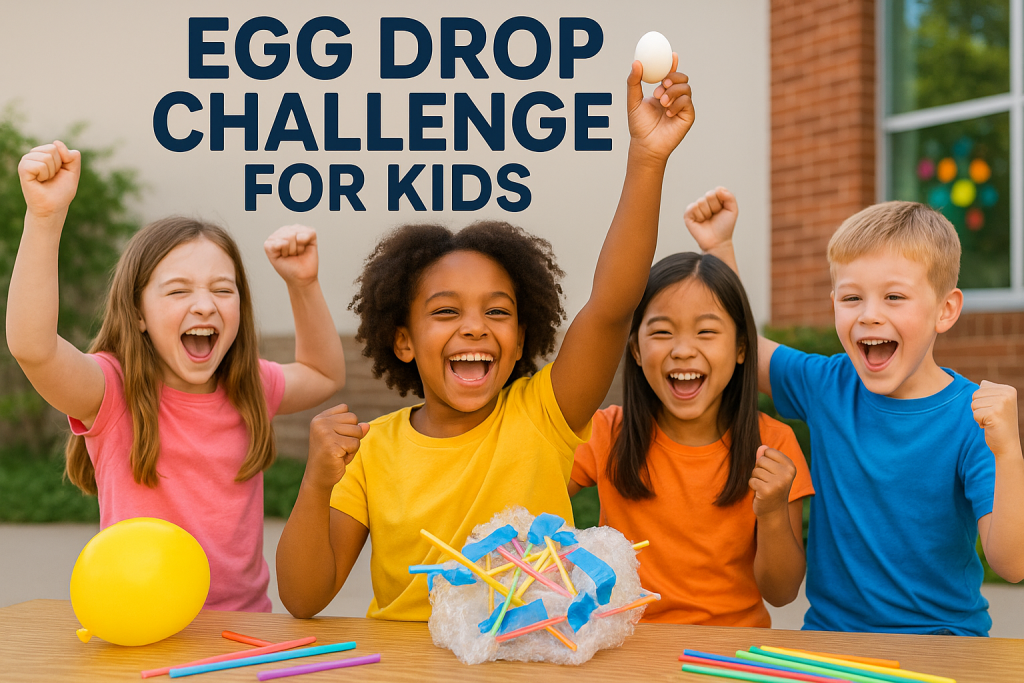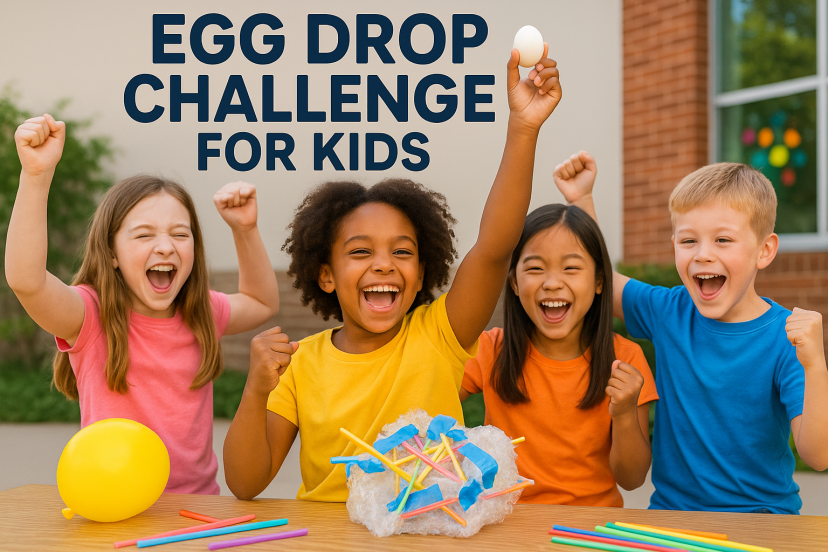10 Egg Drop Challenges for Kids
We may earn a commission for purchases made using our links. Please see our disclosure to learn more.
Looking for a hands-on STEM activity that’s affordable, memorable, and genuinely exciting? Egg Drop Challenges for Kids tick all those boxes and more. Not only do they get everyone off screens, but they also spark creativity, teamwork, and scientific thinking. In each challenge, kids design a contraption to keep a raw egg safe during a dramatic fall—using nothing but simple materials, their imagination, and a dash of bravery.
This article walks you through ten unique egg drop challenges for kids, each with a twist to keep everyone engaged. Whether you’re a parent, teacher, or STEM club leader, you’ll find fun ideas that encourage problem-solving and resilience. Ready to see whose egg will survive the drop? Let’s dive in!
1. The Classic Paper-and-Tape Challenge
Start simple: hand out a few sheets of paper and some masking tape to each kid or team. The mission? Use only these supplies to build a safe “egg container.” Let them fold, roll, or scrunch the paper however they want.
After 20 minutes of building, drop the eggs from shoulder height (or higher if you dare). This old-school challenge highlights creative thinking—kids quickly learn that sometimes the most basic materials can do the trick!
2. Balloon-Powered Egg Protection
Add a floaty twist: give kids a few balloons and tape. The idea is to cushion the egg’s fall by using the balloons as shock absorbers. Some kids might attach balloons around the egg, while others build a basket.
This approach introduces concepts like air resistance and impact absorption. Plus, popping balloons add extra drama to the experiment!
3. Parachute Drop with Plastic Bags
Want to teach about air drag and slow-motion falls? The parachute challenge is a winner. Each team gets a plastic grocery bag, string, and a cup or small box to hold the egg.
Kids must engineer a working parachute so the egg floats gently to the ground. Experiment with different parachute sizes and string lengths to see what works best. It’s a lesson in physics disguised as pure fun.

4. Popsicle Stick Engineering
Time to get crafty! Arm your young engineers with popsicle sticks and glue (or rubber bands). Their goal is to create a sturdy cage or frame around the egg.
Popsicle sticks can be arranged into boxes, triangles, or even “shock-absorbing” designs. This egg drop challenge really tests their building and planning skills.
5. Recycled Materials Egg Drop
Make it green! Ask kids to collect clean recyclables—plastic bottles, newspaper, egg cartons, and bubble mailers work well. Give everyone a mix and see who can invent the most eco-friendly egg-saving device.
Encourage discussions about waste and sustainability. After the challenge, vote on the most creative, most protective, and greenest designs.
6. Marshmallow & Toothpick Towers
This sweet twist on the classic uses mini marshmallows and toothpicks to build a structure around the egg. Kids quickly discover the challenge of balancing strength and cushioning.
Once the structures are done, drop the eggs—preferably outside! Marshmallows help absorb shocks, but clever designs make the difference between a splat and a win.
7. Bubble Wrap & Cotton Padding
Let kids experiment with padding and insulation using bubble wrap, cotton balls, or packing peanuts. The catch: limit how much padding each team can use to encourage creative design instead of just “wrapping it up.”
Challenge them to balance protection with size and weight. Will a heavier, bulkier package help—or hurt—the chances of survival?
8. The “Only Nature” Challenge
Send kids outdoors to gather natural materials—grass, leaves, twigs, pinecones, or moss. Their mission is to use only what they find (plus a little twine or string) to build a natural egg protection device.
It’s a fantastic way to encourage outdoor exploration, creativity, and appreciation for nature’s engineering.
9. Water Cushion Experiment
This one gets a little messy—but it’s always a hit! Kids design a container that lets the egg land in a bag or cup of water. Water acts as a natural shock absorber, but the real trick is making sure the egg doesn’t escape or get soaked.
Tweak the rules: can they use a balloon filled with water? Or must the egg land inside a floating cup? Every version sparks new ideas.
10. The Teamwork Tournament
Turn the egg drop into a friendly competition. Divide the group into teams, set clear rules for materials and drop heights, and let everyone present their designs before the big drop.
Offer prizes for “Best Egg Survivor,” “Most Creative,” and “Most Dramatic Crash.” This format builds collaboration, confidence, and lots of laughter.
Helpful Tips for Egg Drop Success
- Test before the big drop: Try mini drops from a lower height first.
- Emphasize teamwork: Encourage sharing ideas and building together.
- Predict and reflect: Ask kids to guess what will happen, then talk about why it did or didn’t work.
- Embrace the mess: Some eggs will break—celebrate the attempt and brainstorm ways to improve.
- Try different heights: The higher the drop, the greater the challenge!
- Explore more STEM at home: If you’re looking for even more creative, tech-inspired STEM projects, check out this guide to kid-friendly smart home activities for hands-on learning and inspiration.
Scientific Insights: How Egg Drop Challenges Support STEM Learning
If you’re wondering whether egg drop challenges really boost learning, research says yes! Let’s explore two standout studies that reveal why these activities matter for kids—and how you can use their findings to make your next challenge even better.
Eggs Survive Better When Dropped Sideways: Surprising Physics Research
A 2025 study published in Communications Physics turned a classic egg drop myth on its head. Scientists discovered that eggs dropped horizontally (on their side) were actually much less likely to break than those dropped vertically. While it might seem like the tip or base is the “strongest,” the research found that sideways drops allowed the egg to absorb more impact before cracking.
This insight is a fantastic way to introduce real scientific method to your challenge. Ask kids to predict which orientation will work best—then let them test both ways!
Project-Based Egg Drop Activities Improve Physics Learning
Wondering if egg drop challenges have a lasting impact on kids? According to a 2021 study on Project-Based Learning, the answer is yes. When teachers used the egg drop as a hands-on project, students showed stronger connections to real-world physics concepts like force, momentum, and impact. Engagement and positive attitudes toward science soared, with students saying the challenge made physics feel more fun and relevant.
For parents and teachers, this is proof that egg drop challenges are more than a messy good time—they’re a proven way to spark deeper learning and excitement for STEM.

Recommended Products from Amazon
Here are a few affordable, ready-to-go kits and supplies for your next Egg Drop Challenge. These options save time on gathering materials and keep the fun focused on learning!
Teacher Created Resources STEM Starters Egg Drop Kit – Perfect for younger kids or classroom settings, this kit includes all materials and instructions needed for multiple egg drop designs.
Bulk Bubble Wrap & Packing Supplies – Ideal for teams designing cushioned egg carriers (source: bulk retail).
Plastic Balloons & Parachutes STEM Activity Set – Great for experimenting with air resistance and gentle drops.
Conclusion: Learning Through Cracks and Crashes
Egg Drop Challenges for Kids aren’t just about protecting eggs—they’re about sparking curiosity, creative problem-solving, and a love of science. Whether you try the classic version or invent your own, these activities offer a chance to experiment, fail, and try again. Kids learn that even when things crack or crash, there’s always a lesson hiding in the mess. Next rainy day, snow day, or school holiday, pull out an egg and get ready to drop into fun, hands-on learning!
Ready to get started? Grab a few supplies, gather your team, and see who can keep their egg in one piece!
FAQs
Q1: What is an egg drop challenge for kids?
An egg drop challenge is a fun, hands-on STEM experiment that asks kids to invent a contraption capable of keeping a raw egg from cracking when it’s dropped from above.
Q2: What materials work best for an egg drop?
Common materials include paper, tape, straws, popsicle sticks, bubble wrap, balloons, and recyclables. You can also get creative with marshmallows, cotton balls, or even natural items found outdoors.
Q3: How high should I drop the egg for a challenge?
Start with shoulder height or from a low ladder. For older kids, try a second-story window or higher—just be sure it’s safe!
Q4: Can you do an egg drop challenge indoors?
Absolutely. Just lay down a tarp or old sheet to catch any mess. Smaller drops are less likely to cause a mess, but safety first.
Q5: What do kids learn from egg drop challenges?
Kids build skills in engineering, teamwork, creative thinking, and scientific reasoning. It’s a perfect way to introduce concepts like gravity, impact force, and design iteration.


